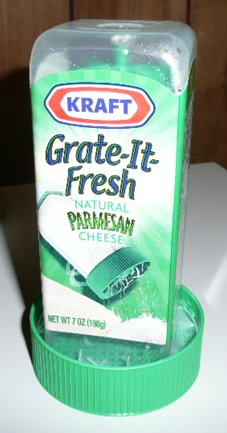Review: Kraft Grate-It-Fresh Parmesan Cheese with Disposable Grater
I never thought that I'd ever be
taking the time to write a review about cheese on my web server. (In
all fairness, the list of things that I never thought I'd end up doing
is a long one, just so you know.)
Nor did I really think that anyone
would care about a review of something as common as parmesan cheese.
But I have written about other things that I thought nobody would ever care about,
and actually have received comments. So, who knows. I also didn't think
that I'd find much information other than whatever blurb Kraft Foods
had decided to write about this product. I was apparently wrong.
If you're looking to actually buy
this Kraft product at your local grocery store, it looks something like
this after the cheese is gone:
Most of the reviews of this product
have been negative in nature. I don't entirely disagree with them, and
for at least one of the same reasons that were pointed out. My biggest
issue is with the concept of taking a perfectly good grater and
throwing it out after you've used it. Like most products that are
supposed to be disposable, major functional parts of the grater
probably remain perfectly functional after the cheese is gone. I don't
like that. I'm no big environmentalist, but the fact that so much
perfectly good or reusable-for-something-else material gets left to rot
(very slowly, I might add!) in a landfill kind of rubs me the wrong way.
And of course, you can buy yourself a
grater and keep it for a very, very long time. That will work out
cheaper in the long run, since you will already have the grater and can
buy the cheese at a much lower price. Kraft is definitely selling
convenience here. People will buy into convenient products, though, if
they answer a need or solve a problem in a good way. To a lesser
extent, some people will also buy into a product if it has a certain
novelty to it.
This product certainly has some
novelty. I doubt if I'd buy it again--the reason I bought it in the
first place was because I saw it one day on the dairy shelf at the LeRoy, IL IGA store and wondered what it would be like as compared to pre-grated parmesan. I also wondered how well the grater itself worked.
The first thing to talk about is the
grater. I've come to expect that grated parmesan cheese was more like a
small and relatively dry cheese curd-like product. Not so with
this--the grater actually "grates" the cheese into long thing hairlike
strands. The grater actually seems to work quite well, although I did
have a hard time getting all the cheese to come off of the grater
output so it wouldn't make a mess on the floor and table. The long,
thin strands of cheese are hard to remove, and shaking the package
either doesn't do anything or sends them flying everywhere.
You are supposed to turn the grater
clockwise to dispense the cheese, and it's relatively foolproof. If you
turn it counterclockwise, then the cheese inside loosens up a little,
but enough clockwise rotation will get things back where they belong.
You can't "unwind" the cheese--something in the grater design prevents
counterclockwise rotation from being effective after the first few
turns.
Then there's the cheese itself. It is
safe to say that I've never had parmesan cheese quite like this before.
It tasted good, but all of the parmesan cheese I've ever had has tasted
not only sharp but also rather salty. This cheese is sharp without
being salty. It was an interesting difference, and I'm not sure where
it came from or what the difference would be between the two. The
cheese itself was different while still tasting very good.
All in all, I'd recommend the
product. It's worth at least one try if you see it in your grocery
store and have a couple of extra bucks to spend. The cost is about $5
in the US, so it's not much different than a name brand can of
pre-grated (or shredded) parmesan cheese.
That only leaves one more thing to
talk about, and that's the disposable nature of the grater package.
Lots of things are sold as disposable items, such as Dallas clock modules, disposable cameras
and even some cars and computers. Of course, whenever the most
consumable part of a disposable product is used up, other perfectly
good parts are left behind and may be reused for other purposes. Kraft
has printed a notice on the package that is supposed to make you
believe that the grater package is not reusable and Must Be Thrown Away
when you are out of cheese.
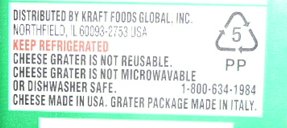
Curiously, the cheese is made in the US while the grater is made in Italy. Shouldn't that be the other way around?
Perhaps even more curious is the
"cheese grater is not microwaveable or dishwasher safe" admonition on
the back. I suspect that at least the first part of that warning is the
requisite "idiot-proofing". The truth is that you don't get to use all
the cheese in the package anyway. The last half inch or so of cheese
will not come out and the grater just slips after that.
But you can open the grater, and
after studying it, I feel very strongly that it could be easily
reloaded with fresh cheese, thusly keeping it out of the landfill. A
side benefit is that the grater package itself costs less than most
graters do. So I'm going to tell you the secret behind opening the
grater package, and you are going to act excited like you have just
received a valuable money saving tip. (Because, in a way, you have.)
It isn't rocket science to open the
grater. (I know this is true because I'm not a rocket scientist and I
figured it out within a minute or two of looking at it.) Start by
holding the clear part of the grater package firmly with your fingers.
Hold it so the green wheel that you normally hold while turning the top
is facing down.
Curl your fingers around the lip of
the green wheel, and flex it outward a little bit while firmly pulling
down. Go around the sides doing this, and you'll hear popping noises as
the plastic assembly comes in two. When you've done all four, you can
lift the clear top away from the green wheel, and you will have
something that looks like this (only with a block of ungrated cheese at
the bottom).
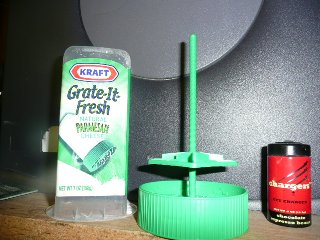
If you haven't yet figured this out,
you can "unscrew" the green plate from the threaded shaft it lives on.
Then--if you haven't already--you can eat the little chunk of cheese
that's left over.
With the plate unscrewed, you can
closely examine the magic of the grater. It's nothing more than a bunch
of little pointy plastic pieces that do the grating work, as you might
be able to see in the following picture.
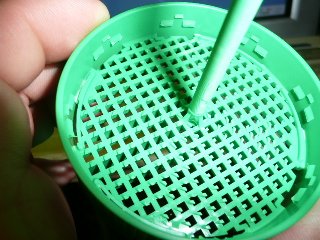
The teeth are only plastic, so I
suppose they might wear down after a while, if you grate frozen cheese
with them, or if you take this grater with you on the set of the Iron
Chef TV show.
Anyway, when you've gotten the grater
completely apart, you will have the following three pieces. They can
all be washed by hand. I haven't checked on the dishwasher "safeness"
of the grater, but if motherboards are dishwasher safe, this thing surely has a chance of being safely placed in the dishwasher as well.
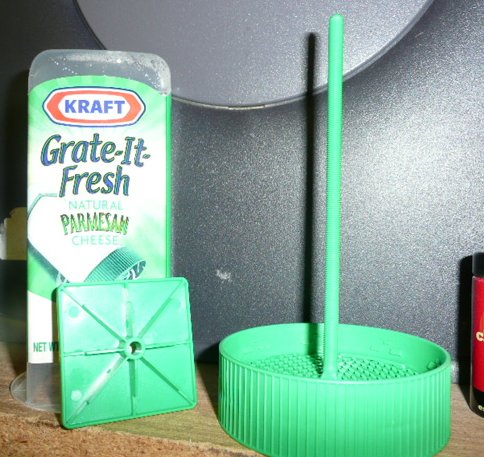
It would be fairly easy to simply get
a new block of parmesan cheese, find a way of putting a hole down the
center and put it back on the spindle for another go-round after
snapping it closed. So it isn't quite as "disposable" as Kraft might
have you believe.
All in all, I'd rate the Kraft Grate-It-Fresh product like this:
Novelty: 85%
Value for Money: 65%
Reusability: 90%
It's definitely worth taking one of
these home at least if you see one in your friendly local grocery
store. And you don't even have to eat any worms
to enhance your enjoyment of the product. Sadly, I think it may have
been discontinued. I could find no mention of it on the Kraft web site,
although the expiration date on the can I bought is December 1st, 2008.
It was the last one available in the store.
Go Back>
Copyright ©2008 William R. Walsh. All rights reserved. Permission is granted to
reproduce this work in its entirety with all copyright notices intact.
No fee may be charged for access to this information, other than to
cover any duplicating, media, or connect-time costs. Portions of this
work may be used for other projects, provided credit is given for the
portions of this work that you use and that such works are for
non-profit distribution or information purposes.
